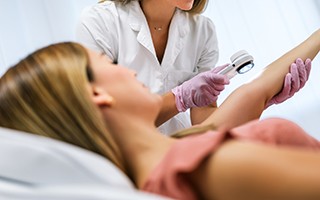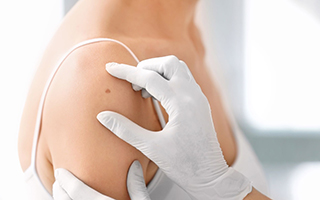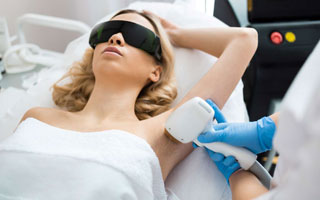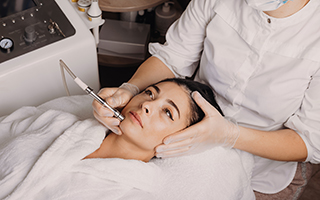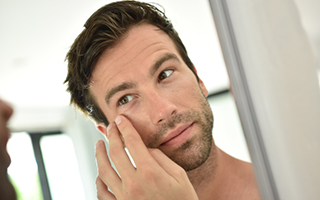Mole & Wart Removal
Learn More About Options for Removing Growths for Bryn Mawr, Newtown Square, Philadelphia, and the Main Line
- Home
- Medical Dermatology
- DERMATOLOGY CONDITIONS
- Mole & Wart Removal
Warts and moles are exceedingly common and usually harmless skin conditions. However, they can be a source of physical discomfort and social embarrassment, which is why many people opt to have them treated. The process of wart and mole removal at our Philadelphia-area practice is efficient and effective.
Discover more options for wart removal and mole removal available from Bryn Mawr Skin & Cancer Institute. To schedule an appointment, Please BOOK ONLINE, call 610.525.5028, or Contact Us.
Our certified dermatologists use the most advanced and safest techniques for eliminating warts and removing moles. Please remember that if you have a mole that is causing you concern because of its size, shape, changing appearance, feel, or color, show it to one of our experienced providers who will further evaluate it. Our team of dedicated dermatologists can answer all of your questions regarding wart and mole removal or any other skin condition.
What Are Warts?
Common warts are a contagious skin condition caused by human papillomavirus (HPV) viruses. They usually form on the hands and feet as rough-textured growths that are often cauliflower-shaped. Warts on the feet can cause walking or exercising to be painful, making wart removal necessary.
Wart Removal Options
Dermatologists most often make the diagnosis of warts with clinical examination, however, a shave biopsy can also be done to confirm the diagnosis. If at-home wart removal treatments aren’t working or warts are becoming a nuisance, dermatologists will utilize medical and surgical wart-removal techniques. These may include topical medications, freezing (cryotherapy), and surgical excisions.
Home Remedies for Wart Removal
There are various at-home treatments that may be effective for wart removal:
- Apply non-prescription, over-the-counter salicylic acid treatments like patches, ointments, or liquids directly to the wart. Be sure to protect the surrounding skin.
- Use non-prescription nitrogen sprays for freezing the wart to destroy the cells (cryotherapy).
- Slough dead skin on the wart with a pumice stone or disposable emery board.
- Soak the skin in diluted apple cider vinegar.
- Apply dilute tea tree oil to the wart.
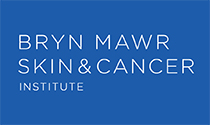
Meet Our Dermatologists &
Certified Physician Assistants
Our board-certified dermatologists & PA-Cs are dedicated to detecting and treating skin cancers. We treat the full spectrum of skin diseases. Our Mohs and Plastic Surgery practices are integrated, and offer patients the most advanced skin cancer treatment, delivering superior outcomes.
What Are Moles?
Moles, also referred to by the medical term nevi, are usually harmless skin growths that can develop on any area of the body. They generally have a uniform black or brown color and can be flat or raised. Whether you think of them as blemishes or beauty spots, they appear on just about everyone’s skin and are caused by pigment-producing skin cells called melanocytes.
Moles often appear in the early stages of a person’s life. They can change slightly as one ages, and new ones can continue to develop. Mole development is believed to be linked to sun exposure and genetics. Patients who find moles unsightly can have cosmetic mole removal. Flat moles may require different mole removal techniques than raised ones.
Types of Moles
Congenital Moles/Birthmarks
Congenital moles are often referred to as birthmarks. They are present at birth or appear shortly thereafter.
Common Moles/Acquired Moles
These are the typical moles seen virtually anywhere on the skin. It is considered normal for people to have between 10 and 40 moles on their body.
Atypical Moles/Dysplastic Nevi
These appear in irregular shapes, colors, and textures. In some cases, atypical moles can become cancerous. Dermatologists recommend checking over your skin monthly and making note of any changes, which you can discuss during your skin cancer exam.
Mole Removal: Can You Prevent Moles?
While it is not possible to change your genetic predisposition for mole development, you can take steps to keep your existing moles healthy and to deter the development of new ones. Practice sun protection at all times, including the use of a broad-spectrum sunscreen, covering up with sun-protective clothing, and seeking shelter from the sun during peak hours.
Mole Removal Options
Dermatologists advise against at-home mole removal techniques. You may inadvertently remove a pre-cancerous or cancerous mole or cause complications in a benign mole. Dermatologists will often perform a biopsy of a mole for further evaluation before deciding on mole removal specifics. Dermatopathologists examine the biopsy specimen under the microscope and render a definitive diagnosis.
Mole removal can be accomplished with a shave biopsy or an excisional biopsy. Excisional biopsies require sutures. Mole removal is considered a minor surgical procedure.
Discover more options for wart removal and mole removal available from Bryn Mawr Skin & Cancer Institute, serving Bryn Mawr, Newtown Square, and Philadelphia. Please BOOK ONLINE, call 610.525.5028, or Contact Us to schedule an appointment.




